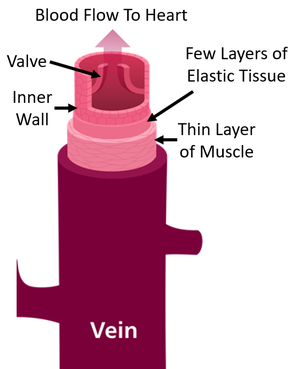Vein
Contents
Key Stage 3
Meaning
An vein is a blood vessel which carries blood to the heart.
Key Stage 4
Meaning
An vein is a blood vessel which carries low pressure blood to the heart.
Adaptations of Veins
- Veins have a thin layer of muscle because the blood is a low pressure.
- Veins have few layers of elastic tissue as the blood is a low pressure.
- Veins have valves in them to stop the blood flowing in the wrong direction because it is such a low pressure.
- Veins often pass between muscles which work with the valves by contracting to force the blood through the vein.
| A diagram of a vein. |
About Veins
- Most, but not all, veins carry deoxygenated blood.
- The pulmonary vein carries oxygenated blood from the lungs to the heart.
References
AQA
- Vein, pages 113, 205, GCSE Biology; Student Book, Collins, AQA
- Veins, page 31, GCSE Combined Science; The Revision Guide, CGP, AQA
- Veins, page 35, GCSE Biology; The Revision Guide, CGP, AQA
- Veins, page 78, GCSE Combined Science Trilogy; Biology, CGP, AQA
- Veins, page 84, GCSE Biology, CGP, AQA
- Veins, pages 51, 53-4, GCSE Biology, Hodder, AQA
- Veins, pages 51, 53-4, GCSE Combined Science Trilogy 1, Hodder, AQA
- Veins, pages 54-55, 141, GCSE Biology; Third Edition, Oxford University Press, AQA
Edexcel
- Veins, page 167, GCSE Biology, Pearson, Edexcel
- Veins, page 265, GCSE Biology, CGP, Edexcel
- Veins, page 62, GCSE Combined Science; The Revision Guide, CGP, Edexcel
- Veins, page 90, GCSE Biology; The Revision Guide, CGP, Edexcel
- Veins, page 30, Gateway GCSE Combined Science; The Revision Guide, CGP, OCR
- Veins, page 37, Gateway GCSE Biology; The Revision Guide, CGP, OCR
- Veins, pages 75-76, Gateway GCSE Biology, Oxford, OCR
